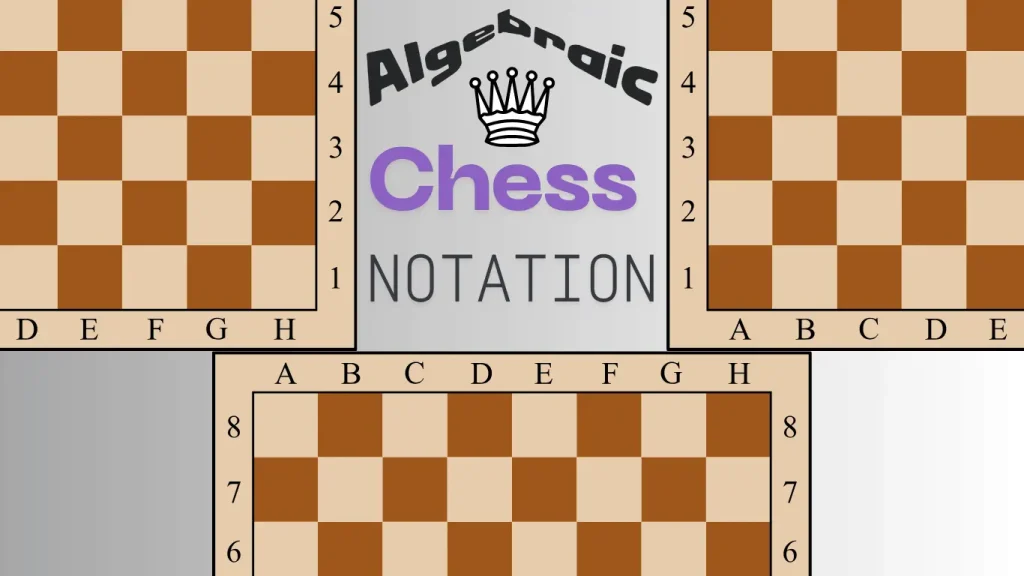Ever watched a chess video and felt confused by mysterious symbols like e4 or Nf3? You're not alone! These aren't random codes—they're part of algebraic chess notation, the universal language that chess players worldwide use to record and share their moves. Once you master this simple system, you'll unlock access to grandmaster strategies, classic chess literature, and be able to analyze every game you play.
Think of chess notation as learning to read a map. Just like every location has an address, every square on the chessboard has its own unique coordinate. Let's decode this friendly system step by step.
What is Chess Algebraic Notation?
Algebraic chess notation is the standard method for recording chess moves using a coordinate system. Each square on the chessboard receives a unique name by combining a letter (file) and number (rank). For example, e4 refers to the square located at the intersection of the e-file and 4th rank.
This notation system was developed to replace older, more complex methods and has become the international standard recognized by FIDE (World Chess Federation). Whether you're reading a chess book in New York or watching a tournament in Mumbai, the notation remains exactly the same.
Chess Board Coordinates Explained: The 64-Square Map
Imagine the chessboard as a perfectly organized grid—eight columns intersecting with eight rows—where every square has its own postal address.
Files (Vertical Columns: a-h)
Ranks (Horizontal Rows: 1-8)
Essential Setup Rule
Always remember: "White on the right"—the bottom-right square (h1) should be light-colored when setting up your board. This ensures proper orientation for notation.
Chess Piece Symbols and Abbreviations
In algebraic notation, each piece wears a single-letter badge—except pawns, which go nameless
Important Note: The Knight uses "N" (not "K") because "K" is reserved for the King. When you see just a square name like d4, it always means a pawn moved there.
How to Write Basic Chess Moves
Piece Letter + Destination Square
Basic Move Examples:
Writing Your First Game
Recording Captures and Special Moves
Captures with an "x"
Special Chess Symbols
Game Results
Advanced Notation: Avoiding Confusion
Sometimes two identical pieces can reach the same square. When this happens, you must disambiguate (clarify which piece moved):
Disambiguation Examples:
Chess Notation Examples with Diagrams
Let's trace through a complete mini-game with notation:
The Scholar's Mate (4-move checkmate):
Common Chess Notation Mistakes to Avoid
Even experienced players make these errors:
Top 5 Notation Mistakes:
Practice Exercises and Score Sheets
Exercise 1: Basic Notation
Using Score Sheets in Tournaments
Score Sheet Template Structure:
Annotating Your Games: Adding Comments
Make your games come alive with evaluation symbols:
Move Quality Symbols:
Example Annotated Game:
Digital Chess Notation: PGN Format
PGN (Portable Game Notation) is the digital standard for storing complete chess games. It includes:
Sample PGN:
Your Next Steps to Notation Mastery
1. Practice Daily
2. Study Master Games
3. Join the Community
Frequently Asked Questions
How do you write algebraic notation in chess?
Write the piece letter (K, Q, R, B, N) followed by the destination square. Pawns use only the square name. Example: Nf3 (knight to f3), e4 (pawn to e4).
What does "d4" mean in chess notation?
d4 means a pawn moved to the d4 square. The "d" indicates the d-file (4th column from White's left).
How do you show check in notation?
Add a "+" symbol after the move. Example: Qh5+ means the queen moved to h5 and gave check.
What does "0-0" mean?
0-0 represents kingside castling (short castling). 0-0-0 means queenside castling (long castling).
How do you write captures?
Use an "x" between the piece and destination square. Example: Nxe5 (knight captures on e5), exd4 (e-pawn captures on d4).
How do you show pawn promotion?
Use "=" followed by the new piece. Example: e8=Q (pawn promotes to queen on e8).
What is disambiguation in chess notation?
When two identical pieces can reach the same square, specify which piece moved by adding the file or rank. Example: Rad1 (rook from a-file to d1).
Master Chess Notation Today
Congratulations! You now possess the key to chess's universal language. Algebraic chess notation opens doors to:
Your chess adventure awaits—equipped with notation skills, you're ready to explore the infinite world of chess knowledge, one move at a time!
Ready to put your notation skills into practice? Visit ChessBazaar.com for premium wooden chess sets perfect for recording your memorable games on quality boards that will last generations. Every great chess journey begins with the right equipment and the knowledge to document it properly.



